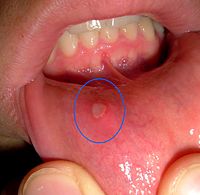
Photo from wikipedia
Objectives The aim of this study was to characterise and describe patterns of temporomandibular joint (TMJ) injuries occurring in cats using CT. Methods A cross-sectional study was carried out in… Click to show full abstract
Objectives The aim of this study was to characterise and describe patterns of temporomandibular joint (TMJ) injuries occurring in cats using CT. Methods A cross-sectional study was carried out in adherence with the STROBE guidelines. Among the medical and CT records of 79 cats, 158 TMJs were reviewed in a collaborative study between six institutions. Results TMJ injuries were most commonly unilateral, representing 70.9% of cases. The mandibular condyle was fractured in 88 cases (55.7%) of the 158 TMJs observed. Of those, 84.0% were intra-articular condyle fractures, with the medial half of the mandibular condyle over-represented. Luxations occurred in 32.9% of cases, which was 19.0% of all evaluated TMJs. Rostrodorsal luxations were most common representing 87.0% of all luxations. Temporal bone fractures were observed in 30.4% of all cases, which was 18.4% of TMJs. The majority of fractures were of an unknown cause. When the cause was determined, road traffic accident (RTA) was the most frequent, followed by animal interaction, other external forces (sharp or blunt force) and high-rise trauma. Bilateral injuries were 13.1 times more likely to occur in high-rise trauma (P = 0.01) and temporal bone fracture was significantly associated with RTAs (P = 0.016). No other significant associations were observed between cause of injury and the resulting TMJ injury pattern. Conclusions and relevance Various TMJ injury patterns can occur in cats as a result of trauma. Intra-articular fractures of the medial half of the mandibular condyle occur most commonly. Although unilateral injuries are more frequent, high-rise trauma tends to present with bilateral lesions. Further studies with a larger sample size should be performed to better understand TMJ patterns of injury and how they relate to possible causes.
Journal Title: Journal of Feline Medicine and Surgery
Year Published: 2022
Link to full text (if available)
Share on Social Media: Sign Up to like & get
recommendations!